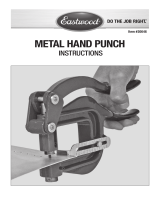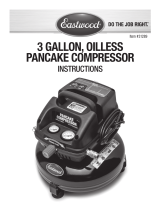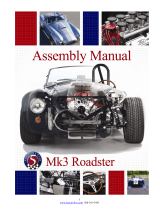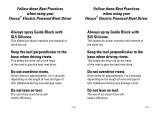Page is loading ...

SOLID RIVET KIT
INSTRUCTIONS
Item #20127

2 Eastwood Technical Assistance: 800.544.5118 >> techelp@eastwood.com
READ INSTRUCTIONS!
Thoroughly read and understand this instruction manual before use. Save manual
for future reference to safety warnings, maintenance and operating procedures.
Failure to follow all warnings can result in tool damage or serious physical injury.
SAFETY INFORMATION
The Eastwood Solid Rivet Kit has everything required to allow the user to produce high-quality,
professional and great looking aircraft grade solid riveted panel joints to assemble their projects.
OPERATIONAL HAZARDS!
• Do not exceed 45 psi of tool inlet air pressure. Permanent Rivet Gun damage
and or personal injury could occur.
• Wear approved eye protection at all times when Driving Rivets for protection from
possible ejected metal chips and shards which can be ejected at high velocity.
• Keep loose clothing, jewelry and long hair away from moving components as
serious personal injury can occur.
• Always disconnect the Rivet Gun from air supply when changing bits to avoid
accidental tool starting or serious personal injury can occur.
• Always make sure the workpiece being riveted is securely clamped or anchored
to allow two handed operation of the tool.
• Avoid running the Rivet Gun freely without a work load or internal tool damage
will occur.
• Use ear protection.
SPECIFICATIONS
• Shank Capacity: Standard 0.401" Parker Taper
• BPM: 4,500
• Air Consumption: 2.3 cfm [65 lm]
• Max. operating air pressure: 90 psi
• Inlet thread size: 1/4" FNPT
• Piston bore diameter: 0.75"

To order parts and supplies: 800.345.1178 >> eastwood.com 3
INCLUDES
(1) Pneumatic Rivet Gun
(1) 1/8" Rivet Set
(1) 3/16" Rivet Set
(1) Bucking Bar
(1) 1/4 lb. Bag of 1/8" Rivets (MS20470-4-3)
(1) 1/4 lb. Bag of 3/16" Rivets (MS20470-6-5)
(1) 1/8" Cleco kit
(1) 3/16" Cleco kit
FIG. A
1/8" Rivet Set
Rivet Gun & Retaining Spring
3/16" Rivet Set
Bucking
Bar
1/4 lb., 1/8" Rivets
(approx. 250 pcs)
1/4 lb., 3/16" Rivets
(approx. 200 pcs)
Cleco pick
3/16"
Cleco
Side Clamps
1/8"
Cleco

4 Eastwood Technical Assistance: 800.544.5118 >> techelp@eastwood.com
RIVET DRIVING
Solid Rivets are a permanent means of mechanical fastening. Many aircraft, truck trailers, boats,
race cars and other high-stress vehicles have extensive use of Solid Rivets in their assembly.
They are a good, secure way to attach two pieces of
metal together without the use of welding
while offering great looking results. This is impor-
tant if you are building a project that requires
reliable structural integrity such as a car, repairing
aircraft or creating something where welding
is not practical or possible.
Basically, a rivet is a smooth, cylindrical shaft with
a head on one end ( FIG. B). The plain end opposite
the head is called the “buck-tail”. When the rivet is
installed, it is placed into a precisely sized, punched
or drilled hole then “driven” permanently in place. A
Rivet Set (FIG. A) of the correct size and contour to match the rivet is placed over the head and with
a Bucking Bar (FIG. A) supporting the buck-tail, force is applied to the head, deforming the tail. Done
properly, the tail expands or “mushrooms” to about 1-1/2 times the rivet shank diameter. It is critical
that the Rivet Set be applied straight-on to the Rivet Head during the driving operation and the Buck-
ing Bar be held completely parallel to the tail when force is being applied.
It is not difficult to install solid rivets into a workpiece, but success depends on making an even,
mushroomed end so that it securely and tightly holds the two pieces together.
The following are some steps to get you started in driving solid rivets in your next project.
IMPORTANT NOTE: Driving Rivets properly requires a moderate learning curve. It is strongly advisable
to practice the rivet driving technique on scrap material before beginning work on an actual project.
It always is best to waste some rivets and several pieces of scrap than to be disappointed by ruining
a time intensive project.
1. PLAN THE PROJECT – There are a number of great methods available for joining panels such
as simple panel overlapping, using backer strips to maintain a flush appearance, gusset plates
and more. If possible, observe and study other riveted assemblies to get an idea of what joining
method works best for your project.
2. ALIGN PANELS – Before any holes are drilled, the panels to be joined must be aligned. Be sure
that they are aligned perfectly, as they cannot be separated without breaking or grinding away
the rivets if a mistake is made. Once aligned, hold the panels securely in place with clamps so
you can move onto the next step.
FIG. B
Round
(Universal)
Head
Shank “Bucktail”
Diameter
(In 32nd’s)
Length
(In 16th’s)
IMPORTANT NOTE: A regulator must be used on the Rivet Gun to set the correct pressure.
For proper control the pressure to the gun should be 40-45 psi.

To order parts and supplies: 800.345.1178 >> eastwood.com 5
3. PLANNING HOLE LOCATIONS – For maximum joint strength and to avoid possible tearing of
joined panels under stress, the proper panel edge-to-hole centerline and hole centerline-to-hole
centerline spacing should be observed. Note: This spacing is as defined by FAA specification
AC 43.13-1B and by MIL spec MIL-HDBK-5 and is determined by rivet size (FIG. C & D).
4. HOLE LOCATION LAYOUT – Using an accurate measuring device and a firm straightedge,
measure and mark edge to hole centerline dimension on the panel (FIG. E & F), next, measure
and mark hole centerline to hole centerline dimensions on panels. NOTE: The use of a center
punch to locate holes is strongly recommended. NOTE:
C
L = center line
1/4" Edge To Hole
RIVET HOLE SPACING FOR 1/8" RIIVETS
Edge To Hole
1/4"
1/2" Hole To Hole
SINGLE ROW
1/4" Edge To Hole
1/2" Hole To Hole
Edge To Hole
1/4"
DOUBLE ROW LINEAR
1/2"
1/4" Edge To Hole
1/2" Hole To Hole
Edge To Hole
1/4"
1/2"
1/4
"
DOUBLE ROW STAGGERED
1/2"
RIVET HOLE SPACING FOR 3/16" RIIVETS
3/8" Edge To Hole
Edge To Hole
3/8"
3/4" Hole To Hole
SINGLE ROW
3/8" Edge To Hole
Edge To Hole
3/8"
3/4" Hole To Hole
DOUBLE ROW LINEAR
3/4"
3/8" Edge To Hole
3/4" Hole To Hole
3/4"
Edge To Hole
3/8"
DOUBLE ROW STAGGERED
3/4"
3/8"
FIG. CFIG. D
FIG. E FIG. F

6 Eastwood Technical Assistance: 800.544.5118 >> techelp@eastwood.com
5. CLAMPING PANELS – There are several methods
for clamping panels however we have found that
the Blind Grip Holders or Cleco
™
style work the
best. They are available in 1/8" or 3/16" sizes to
fit the corresponding drilled rivet holes (FIG. G).
6. DRILL RIVET HOLES – Using the same diam-
eter drill bit as the solid rivets (1/8" or 3/16" as
required), the holes can be drilled for the rivets.
NOTE: The use of a new, sharp drill bit is strongly
recommended for best results (FIG. H). Deburr
both sides of all drilled holes and apply a light
coating of a rust or corrosion inhibiting product
on all hole edges if using steel panels.
7. PLACING RIVETS INTO HOLES – Once the holes
are all drilled into the workpiece, the rivets can be
inserted and permanently worked in place (FIG. I).
NOTE: It is advisable to insert and drive each rivet
one at a time to avoid mistakes. If a rivet is hard
to install in the drilled hole, do not force it or use
the Rivet Gun and Rivet Set to install. Instead,
remove rivet and run the appropriate size drill bit
(1/8" or 3/16") through the hole again.
FIG. G
FIG. H
FIG. I

To order parts and supplies: 800.345.1178 >> eastwood.com 7
8. DRIVING RIVETS – The proper sized Rivet Set is
placed into the Pneumatic Rivet Gun and cupped
over the rounded head of the rivet (FIG. J).
IMPORTANT NOTE: It is critical that the Rivet Set
be applied straight-on to the rivet head during the
driving operation or rivet head damage and failure
will occur. At the same time, the Bucking Bar
is placed on the opposite side of the panel,
against the rivet tail and held squarely and
firmly in place (FIG. J).
IMPORTANT NOTE: It is critical that the Bucking
Bar is kept square and parallel to the rivet tail
during the driving operation or rivet damage
and failure will occur.
• Slowly depress the Rivet Gun trigger, letting
the throttling action control the hammering
force. As the hammering force of the Rivet Gun
is applied to the rivet head, the tail of the
rivet will “mushroom” or spread to approx.
1-1/2 times the rivet shank diameter (FIG. K).
• Proper orientation of Rivet Set and Bucking Bar: (FIG. J) Shows
the correct orientation of the Rivet Set on the Rivet Head and the
Bucking Bar on the Tail. (FIG. L) Shows the incorrect orientation
of the Rivet Set on the Rivet Head.(FIG. M) Shows the incorrect
orientation of the Bucking Bar on the Tail.
9. REPEAT THE PROCESS – After the first rivet is successfully driven,
the remaining rivet installation can be completed. Note: when work-
ing with many rivets on a large project or on curved surfaces, use
care to keep the panels securely clamped to equalize stress and avoid
panel misalignment or warpage. The use of Cleco
™
style clamps is highly
recommended (FIG. N).
10. CHECKING YOUR WORK – Once all of the rivets are properly driven in
place, you will need to go around and check them all for a tight fit. If any
are loose, or move around at all, you will need to give them another punch
or two with the Rivet Gun. All the rivets should be completely secure so that the panel joints will
be strong as possible.
11. CONGRATULATIONS – At this point you have successfully mastered the art of Solid Riveting
and are well on the way to creating many high-strength panel joints and great looking projects!
FIG. J
FIG. K
FIG. L
FIG. M
FIG. N
CORRECT
INCORRECT
INCORRECT
IMPORTANT NOTE: Set Rivet Gun to 40-45 psi!

8 Eastwood Technical Assistance: 800.544.5118 >> techelp@eastwood.com
REMOVING IMPROPERLY DRIVEN OR DAMAGED RIVETS
If the rivet head or tail has been deformed or damaged
by incorrectly driving, the rivet must be removed and
replaced. This task is easily accomplished in the
following steps:
1. Center punch the head of the rivet to be replaced
NOTE: the 470 series rivets included in this
kit have a small indentation in the center of
the rivet head. This mark will aid in center
punching (FIG. O).
2. Begin drilling the rivet head with the appropriate
sized drill: Use a 1/8" drill on 1/8" rivets and
a 3/16" drill on 3/16" rivets.
3. Drill only as deep as the rivet head (FIG. P).
4. Use a 1/8" punch on 1/8" rivets (3/16" punch
on 3/16" rivets) to gently “pop” the head off.
To accomplish this insert the punch into the drill
hole in the rivet head and force the punch down
to “pop” the head off. If the head does not easily
pop off simply drill the hole a little deeper.
5. Once the rivet head is removed, use the same punch to push out the rivet tail from the
metal panels.
6. A new rivet can be installed and correctly driven.
This method will accurately remove the damaged rivet without deforming or enlarging the rivet hole.
REPLACEMENT RIVETS
The most common rivets and those used in this
kit are round head, solid shank, aluminum rivets
in 1/8" and 3/16" diameter sizes. They are
typically sized by 16th’s in length and 32nd’s in
diameter. The 1/8" Dia. x 1/4" long rivets in this
kit can be identified as: 4/32" Dia. x 4/16" long
while the 3/16" Dia. x 5/16" long rivets can be
identified as: 6/32" Dia. x 5/16" long (FIG. B).
Round
(Universal)
Head
Shank “Bucktail”
Diameter
(In 32nd’s)
Length
(In 16th’s)
FIG. B
Center Punch Here
FIG. O
FIG. P

To order parts and supplies: 800.345.1178 >> eastwood.com 9
THE RIVET GUN
The Eastwood Rivet Gun is a heavy-duty professional quality tool ruggedly designed for many years
of reliable service. It features a high-performance 4500 bpm (blows per minute) design for quick
and efficient operation. Accepts any standard 0.401" Parker Taper shank Rivet Sets and other air
hammer tool bits.
SET-UP AND CONNECTION
• Be sure that the air supply to the Rivet Gun is clean and dry. Moisture in the supply line will
quickly damage the motor and valves.
• A minimum 3/8" I.D. air line should be used for optimal performance.
Regulate air pressure to 40-45 psi
• Thread the retaining spring onto the machined spiral-grooved end of the Rivet Gun body with
the protruding ear inward. Rotate the spring using the ear as a lever.
• Make sure the Rivet Gun is disconnected from the air supply. The bit is slid into the bore of the
drive piston using the spring to retain it. The Spring must be deflected by pulling firmly outward
and back so that the formed “U” fits over the flange portion of the tool shank. This keeps the
Rivet Set in place while Rivet Driving.
• To remove a bit, disconnect air supply, pull spring “U” outward and back and release tool bit
from bore.
OPERATION
• Disconnect air supply from the Rivet Gun to prevent accidental starting and potential injury
while placing Rivet Set in the bore.
• Place the Rivet Set against Rivet Head and depress trigger to actuate hammering.
Always use two hands to control tool.
• Speed/force is regulated by pressure applied to the trigger.
• Avoid running the Rivet Gun freely without a workload, permanent internal tool damage
can occur.
MAINTENANCE
• Add several drops of air tool oil before each use directly into the air inlet.
• If Rivet Gun is to be unused for an extended period, add 10 drops of air tool oil directly to the
air inlet then store the Rivet Gun handle up.

10 Eastwood Technical Assistance: 800.544.5118 >> techelp@eastwood.com
TROUBLESHOOTING
• Rivet Gun doesn’t respond to trigger depression:
- Verify sufficient air supply to tool.
- Check for moisture in air line and tool air inlet.
• Rivet Gun performance is slow or sluggish:
- Verify sufficient air supply to tool.
- Check for moisture in air line and tool air inlet.
- Stop use immediately and check for bent tool bit or shank.
- Add air tool oil directly to air inlet.
• Rivet Gun emits excessive noise during use:
- Stop use immediately and add air tool oil directly to air inlet.
• Rivet Gun is hard to control or drives rivets too fast:
- Reduce air pressure to 40-45 psi.

To order parts and supplies: 800.345.1178 >> eastwood.com 11
ADDITIONAL ITEMS
#20144 Pneumatic Rivet Gun
#20142 1/8" Rivet Set
#20143 3/16" Rivet Set
#20139 Bucking Bar
#20126 1/4" lb. Bag of 1/8" Rivets (MS20470-4-3)
#20141 1/4" lb. Bag of 3/16" Rivets (MS20470-6-3)
#19073 1/8" Cleco Clamps
#13752 3/16" Cleco Clamps

© Copyright 2014 Easthill Group, Inc. Instruction part #20127Q Rev. 4/14
If you have any questions about the use of this product, please contact
The Eastwood Technical Assistance Service Department: 800.544.5118 >> email: techelp@eastwood.com
PDF version of this manual is available online >> eastwood.com/20124manual
The Eastwood Company 263 Shoemaker Road, Pottstown, PA 19464, USA
US and Canada: 800.345.1178 Outside US: 610.718.8335 Fax: 610.323.6268 eastwood.com
/









